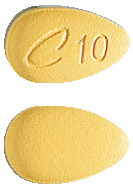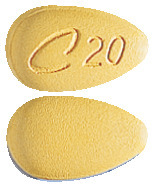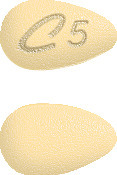SUMMARY CMI
CIALIS®
Consumer Medicine Information (CMI) summary
The full CMI on the next page has more details. If you are worried about using this medicine, speak to your doctor or pharmacist.
1. Why am I using CIALIS?
CIALIS contains the active ingredient tadalafil. CIALIS is used to treat erectile dysfunction and urinary symptoms associated with benign prostatic hyperplasia in adult men.
For more information, see Section 1. Why am I using CIALIS? in the full CMI.
2. What should I know before I use CIALIS?
Do not use if you have ever had an allergic reaction to CIALIS or any of the ingredients listed at the end of the CMI.
Do not take CIALIS if you are currently taking any nitrates or amyl nitrite.
Talk to your doctor if you have any other medical conditions such as heart problems or take any other medicines.
For more information, see Section 2. What should I know before I use CIALIS? in the full CMI.
3. What if I am taking other medicines?
Some medicines may interfere with CIALIS and affect how it works.
A list of these medicines is in Section 3. What if I am taking other medicines? in the full CMI.
4. How do I use CIALIS?
- Always take CIALIS exactly as your doctor has told you.
- Follow all directions given to you by your doctor or pharmacist.
More instructions can be found in Section 4. How do I use CIALIS? in the full CMI.
5. What should I know while using CIALIS?
| Things you should do |
|
| Things you should not do |
|
| Driving or using machines |
|
| Drinking alcohol |
|
| Looking after your medicine |
|
For more information, see Section 5. What should I know while using CIALIS? in the full CMI.
6. Are there any side effects?
CIALIS may cause chest pain, headache or migraine, flushing, sweating, nausea or vomiting, fatigue, back pain, muscle pain. Serious side effects may include: chest pain, increased heart beat, prolonged and painful erection, erection that lasts longer than 4 hours, partial, temporary or permanent vision changes in one or both eyes, sudden decrease or loss of hearing and seizures.
For more information, including what to do if you have any side effects, see Section 6. Are there any side effects? in the full CMI.
FULL CMI
CIALIS®
Active ingredient: tadalafil
Consumer Medicine Information (CMI)
This leaflet provides important information about using CIALIS. You should also speak to your doctor or pharmacist if you would like further information or if you have any concerns or questions about using CIALIS.
Where to find information in this leaflet:
1. Why am I using CIALIS?
2. What should I know before I use CIALIS?
3. What if I am taking other medicines?
4. How do I use CIALIS?
5. What should I know while using CIALIS?
6. Are there any side effects?
7. Product details
1. Why am I using CIALIS?
CIALIS contains the active ingredient tadalafil. CIALIS belongs to a group of medicines called phosphodiesterase type 5 inhibitors.
CIALIS is used to treat:
- erectile dysfunction, also known as impotence, in men. This is when a man cannot get, or maintain, a hard erect penis suitable for sexual activity. Following sexual stimulation, CIALIS works by helping the blood vessels in your penis to relax, allowing the flow of blood into your penis. The result of this is improved erectile function. CIALIS will only treat erectile dysfunction if you are sexually aroused. You and your partner will need to engage in foreplay, just as you would if you were not taking a medicine for erectile dysfunction.
- urinary symptoms associated with a common condition called benign prostatic hyperplasia. This is when the prostate gland gets bigger with age. Symptoms include difficulty in starting to pass urine, a feeling of not completely emptying the bladder and a more frequent need to pass urine even at night. CIALIS improves blood flow to, and relaxes the muscles of, the prostate and bladder which may reduce symptoms of benign prostatic hyperplasia.
Your doctor may have prescribed you CIALIS to treat either, or both of these conditions.
2. What should I know before I use CIALIS?
Warnings
Do not use CIALIS if:
- you are allergic to tadalafil, or any of the ingredients listed at the end of this leaflet. Always check the ingredients to make sure you can use this medicine
- you are currently taking any nitrates, medicines used for the treatment of angina ("chest pain") or other heart conditions. CIALIS has been shown to increase the effects of these medicines.
- if you use recreational drugs called "poppers" or "amyl" like amyl nitrite and butyl nitrite that are normally taken through inhalation
- if you use guanylate cyclase stimulators such as riociguat, used to treat pulmonary arterial hypotension
- if you have heart or blood vessel problems that make sexual intercourse inadvisable. Sexual activity carries a possible risk to patients with a heart condition because it puts extra strain on the heart
- if you have heart problems such as angina, arrhythmias (change in rhythm or rate of heart beat), heart failure
- if you have suffered a heart attack in the last 3 months
- if you have suffered a stroke in the last 6 months
- if your blood pressure is unusually high or low or is not effectively treated
- if you have vision loss in one eye because of non-arteritic interior ischaemic optic neuropathy (NAION).
Check with your doctor if you have or have had:
- liver or kidney problems
- heart problems or if you have had a heart attack
- blood vessel problems
- sickle cell anaemia (an abnormality or red blood cells)
- multiple myeloma (cancer of the bone marrow)
- leukaemia (cancer of the blood cells)
- any deformation of the penis (such as angulation, cavernosal fibrosis or Peyronie's disease)
- sudden decrease in vision, loss of vision, distorted vision and/or dimmed vision affecting one or both eyes. If you experience any of these while you are taking CIALIS, stop taking CIALIS and contact your doctor immediately.
During treatment, you may be at risk of developing certain side effects. It is important you understand these risks and how to monitor for them. See additional information under Section 6. Are there any side effects?
Tell your doctor if you:
- are aged 75 years and over.
You have a higher chance of experiencing side effects like dizziness and diarrhea.
Your doctor will assess if CIALIS is suitable for you.
Use in women
CIALIS is not intended for use by women.
Use in children
CIALIS is not intended for use by children under the age of 18 years.
3. What if I am taking other medicines?
Tell your doctor or pharmacist if you are taking any other medicines, including any medicines, vitamins or supplements that you buy without a prescription from your pharmacy, supermarket or health food shop.
Some medicines may interfere with CIALIS or affect how it works.
These include:
- nitrates, medicines such as glyceryl trinitrate, isosorbide mononitrate and sodium nitroprusside used to treat angina and other heart conditions (see Section 2. What should I know before I use CIALIS?)
- guanylate cyclase stimulators such as riociguat, used to treat pulmonary arterial hypotension (see Section 2. What should I know before I use CIALIS?)
- some antibiotic medicines such as rifampicin, erythromycin and clarithromycin
- some medicines used to treat seizures such as phenytoin, phenobarbitone and carbamazepine
- some medicines used to treat fungal infections such as ketoconazole and itraconazole
- protease inhibitors used to treat HIV such as ritonavir and saquinavir
- medicines used to treat hypertension (high blood pressure) such as metoprolol, irbesartan and enalapril
- alpha-blockers (used to treat hypertension and some prostate problems) such as prazosin and doxazosin
- a 5-alpha reductase inhibitor, such as finasteride (used to treat prostate and hair loss problems)
- warfarin, a medicine used to prevent or treat blood clots
- other PDE5 inhibitors such as sildenafil used to treat erectile dysfunction or pulmonary arterial hypertension (high blood pressure in the blood vessels in the lungs)
- grapefruit juice
- large amounts of alcohol.
Check with your doctor or pharmacist if you are not sure about what medicines, vitamins or supplements you are taking and if these affect CIALIS.
4. How do I use CIALIS?
For Erectile Dysfunction:
- CIALIS can be taken as either on-demand dosing or once-a-day dosing:
- CIALIS on-demand (10 mg or 20 mg) is intended for use prior to anticipated sexual activity and is not for continuous daily use
- CIALIS once-a-day (5 mg) is for patients who anticipate frequent use of CIALIS (i.e. at least twice weekly). Your doctor can advise on the appropriateness of once-a-day treatment. When taken once a day, CIALIS allows you to obtain an erection, when sexually stimulated, at any time point during the 24 hours of the day. - Do not take once-a-day dosing and on-demand dosing concurrently
- When taking CIALIS once-a-day (5 mg), it may take up to 1 week for a full effect on erectile dysfunction.
For urinary symptoms associated with benign prostate hyperplasia
- CIALIS once-a-day (5 mg) is taken daily. It may take up to a week to notice an improvement and 1 month for a full effect on urinary symptoms such as urinating too frequently during the day or at night, the need to urinate being too urgent, or too soon after relieving your bladder.
How much to take
You should not take CIALIS more than once a day.
On-demand dosing for Erectile Dysfunction:
- the maximum recommended dose of CIALIS is one 20 mg tablet taken before sexual activity
- if you have kidney disease, the recommended dose of CIALIS is one 10 mg tablet. This dose may be increased up to 20 mg. For patients with severe renal impairment, 10 mg is the maximum recommended dose
- if you have liver disease, the recommended dose of CIALIS is one 10 mg tablet. Patients with severe hepatic impairment should follow their doctor's advice
- no special dosing consideration is needed for the elderly or people with diabetes.
Once-a-day dosing for Erectile Dysfunction and/or urinary symptoms associated with Benign Prostate hyperplasia:
- the recommended dose of CIALIS is one 5 mg tablet taken once per day
- dose adjustments are not required in patients with kidney disease unless you have severe renal impairment. Once-a-day dosing of CIALIS is not recommended in patients with severe renal impairment.
- patients with liver disease should follow their doctor's advice. Once-a-day dosing is not recommended in patients with severe hepatic impairment.
- no special dosing consideration is needed for the elderly or people with diabetes.
When to take CIALIS
CIALIS can be taken with or without food or alcohol. However, drinking alcohol may affect your ability to get an erection, so avoid excessive drinking.
On-demand dosing for Erectile Dysfunction:
- CIALIS (10 mg or 20 mg) should be taken at least 30-60 minutes prior to anticipated sexual activity
- The amount of time CIALIS takes to work varies from person to person. In some men CIALIS can work as early as 16 minutes after taking the tablet but it is recommended that you allow 1 hour the first time you take it
- CIALIS has been proven to be effective for up to 36 hours. This means you can take CIALIS and it will allow you to obtain an erection when sexually stimulated, at any time during the 36 hours after taking it. Sometimes if you're feeling anxious or nervous you may not respond to the first tablet. Don't give up, it may take a few doses before you get the full benefit of CIALIS.
Once-a-day dosing for Erectile Dysfunction and/or urinary symptoms associated with Benign Prostate hyperplasia:
- CIALIS should be taken daily at approximately the same time of day
- CIALIS must be taken daily to maintain effect.
How to take CIALIS
Swallow one tablet whole with a full glass of water.
If you take too much CIALIS
If you think that you have used too much CIALIS, you may need urgent medical attention.
You should immediately:
- phone the Australian Poisons Information Centre
(by calling 13 11 26) or the New Zealand National Poisons Centre (by calling 0800 POISON or 0800 764 766), or - contact your doctor, or
- go to the Emergency Department at your nearest hospital.
You should do this even if there are no signs of discomfort or poisoning.
5. What should I know while using CIALIS?
Things you should do
If you have emergency treatment for any suspected heart condition, tell the emergency medical or ambulance staff that you are taking CIALIS.
Remind any doctor, dentist or pharmacist you visit that you are using CIALIS.
Things you should not do
- Do not take CIALIS for any other complaints unless your doctor tells you to.
- Do not give you medicine to anyone else, even if they have the same condition as you.
Driving or using machines
Be careful before you drive or use any machines or tools until you know how CIALIS affects you.
Drinking alcohol
Tell your doctor if you drink alcohol.
Alcohol may affect your ability to get an erection. Avoid excessive drinking.
When taking CIALIS with large amounts of alcohol, some men may experience dizziness.
Looking after your medicine
- Store below 25°C.
- Keep your tablets in the original pack until it is time to take them.
Follow the instructions in the carton on how to take care of your medicine properly.
Store it in a cool dry place away from moisture, heat or sunlight; for example, do not store it:
- in the bathroom or near a sink, or
- in the car or on window sills.
Keep it where young children cannot reach it.
Getting rid of any unwanted medicine
If you no longer need to use this medicine or it is out of date, take it to any pharmacy for safe disposal.
Do not use this medicine after the expiry date.
6. Are there any side effects?
All medicines can have side effects. If you do experience any side effects, most of them are minor and temporary. However, some side effects may need medical attention.
See the information below and, if you need to, ask your doctor or pharmacist if you have any further questions about side effects.
Less serious side effects
| Less serious side effects | What to do |
Allergic reaction:
| Speak to your doctor if you have any of these less serious side effects and they worry you. |
Serious side effects
| Serious side effects | What to do |
Heart related:
If you experience chest pain during or after sexual activity: stop what you are doing, sit up and sit forward. Call an ambulance if the pain does not resolve. Do not use nitrates (medicines used for the treatment of angina ("chest pain") or other heart conditions).
| Call your doctor straight away, or go straight to the Emergency Department at your nearest hospital if you notice any of these serious side effects. |
Eye related:
| Stop taking CIALIS and call your doctor straight away, or go straight to the Emergency Department at your nearest hospital. |
*Sudden loss or decrease in hearing which may be accompanied by ringing in the ears and dizziness, loss of vision in one or both eyes and seizures have been reported in people taking CIALIS. It is not possible to determine whether these events are related directly to CIALIS, to other diseases or medications, to other factors, or to a combination of factors. If you experience these symptoms, stop taking CIALIS and contact a doctor immediately.
Tell your doctor or pharmacist if you notice anything else that may be making you feel unwell.
Other side effects not listed here may occur in some people.
Reporting side effects
After you have received medical advice for any side effects that you experience, you can report side effects to the Therapeutic Goods Administration online at www.tga.gov.au/reporting-problems. By reporting side effects, you can help provide more information on the safety of this medicine.
Always make sure you speak to your doctor or pharmacist before you decide to stop taking any of your medicines.
7. Product details
This medicine is only available with a doctor's prescription.
What CIALIS contains
| Active ingredient (main ingredient) | tadalafil |
| Other ingredients (inactive ingredients) | croscarmellose sodium hyprolose hypromellose iron oxide yellow magnesium stearate microcrystalline cellulose sodium lauryl sulfate purified talc titanium dioxide triacetin |
| Potential allergens | lactose |
This medicine does not contain sucrose, gluten, tartrazine or any other azo dyes.
Do not take this medicine if you are allergic to any of these ingredients.
What CIALIS looks like
CIALIS 5 mg tablets are yellow, film coated, almond shaped tablets, marked "C5" on one side (Aust R 128496).
CIALIS 10 mg tablets are light yellow, film coated, almond shaped tablets, marked "C10" on one side (Aust R 90590).
CIALIS 20 mg tablets are yellow, film coated, almond shaped tablets, marked "C20" on one side (Aust R 81137).
Who distributes CIALIS
Eli Lilly Australia Pty Ltd
Level 9, 60 Margaret Street
Sydney NSW 2000
AUSTRALIA
Phone: 1800 454 559
Eli Lilly and Company (NZ) Limited
PO Box 109 197 Newmarket
Auckland 1149
NEW ZEALAND
Phone: 0800 500 909
® Registered Trademark
This leaflet was prepared in October 2024.
vA17
Published by MIMS December 2024







 The improvement in total IPSS in the tadalafil group compared to placebo occurred as early as 1 week in the integrated data from studies LVHJ and LVID.
The improvement in total IPSS in the tadalafil group compared to placebo occurred as early as 1 week in the integrated data from studies LVHJ and LVID.


